How I Broke my Body and Then Fixed It
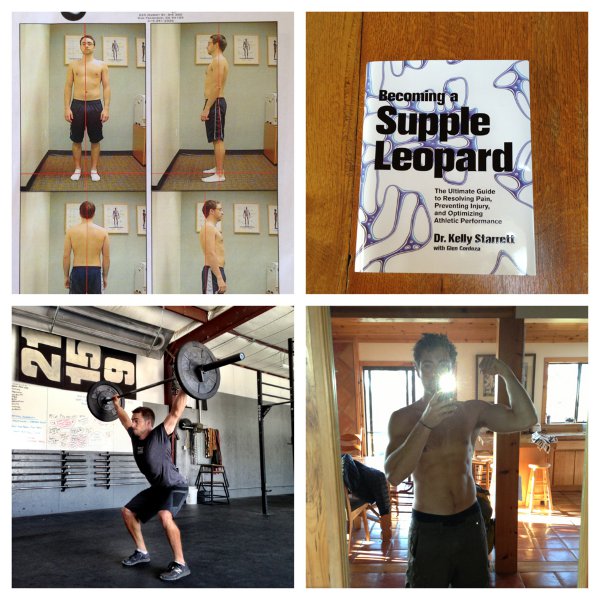
April 23, 2013 – San Francisco, CA
“YEAAAHHHH BOOOOYYYYY!”
My concentration broke long enough to see Kelly Starrett, owner of San Francisco CrossFit, grinning at me from across the room. He seemed pleased.
I was crouched in a deep squat, arms locked out, precariously balancing a weighted barbell overhead—not the best position to lose focus. I tried not to laugh, ground my feet into the ground, and stood up.
Upon arrival two days earlier I couldn’t perform a single air squat without hurting my right knee. I thought explosive movements like the ground-to-overhead Olympic lift I’d just performed would blow my joints apart.
Suddenly it seemed easy.
Three weeks later I would squat 205 lbs. like it was my job. Six weeks later I would press most of my bodyweight overhead and suddenly gain the ability to do free-standing handstand pushups—something I’d never done in my life, nagging shoulder injuries be damned.
After years spent as a broken mess I’d finally figured out why my body was broken and how to fix it. I also learned how to regain and exploit every last ounce of athletic potential I still have in the tank.
It turns out the answers had been right in front of me all along.
—
Editor’s Note: This is a long post, but it’s the summary of 3 years of learning. Skip the backstory and check out the resources at the bottom of if you’re pressed for time. Don’t forget to sign up for email updates (right/bottom) if you’re interested in more from this site. I have no direct affiliation with any product, service, or person written about here (more on this), and these views and opinions here are based on my own experiences and interpretation of the work of others. The material presented here is for informational purposes only. I am not a trained professional, so don’t take any of my advice. And make sure you consult a doctor. LOL.
—
Part I: Injuries that modern medicine can’t fix.
Mid 2010 – Office of Orthopedic Surgeon Kenneth Akazuki, San Francisco, CA
“You sure you’re only 28?”
Dr. Akazuki had an MRI of my right knee in his hand. He slowly turned from the MRI to me, as if he expected some kind of intelligent response to this question.
“I’m sorry?” was all I could blurt out.
Apparently—as Dr. Akazuki enthusiastically pointed out—the meniscus on the inside of my right knee had ground itself into a a fine powder and all but vanished. I had the knees of someone 20 years my senior, and there wasn’t a thing he could do about it.
Akazuki was orthopedic surgeon for the San Francisco Giants, who were at that moment on their way to win the World Series. He was a legit, highly respected Doctor, at the top of his game, and I was hoping he had some kind of magic bullet fix for me.
“So that’s it?”
“Well, I could give you a cortisone injection, or we could scope the knee to see what we find… …but beyond that, since there’s no tear in the meniscus there isn’t really anything I can do.”
I was deflated. I looked over at my reflection in the room’s only mirror: a wizened 152 lbs, out of shape, and as one friend had recently commented, ‘visibly diminished’.
What the hell happened?
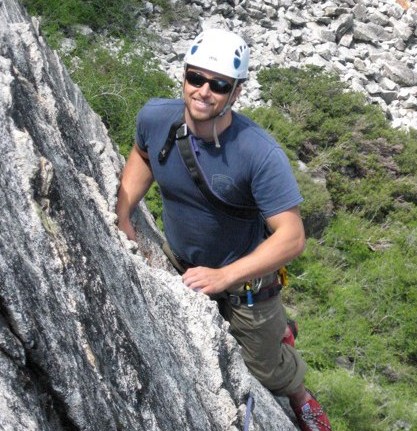
Rewind 8 months: 5’9″, 172 lbs, 27-years old—I was a machine, fitter than I’d ever been, with a penchant for overdoing physical activity to the a point of ridiculousness.
This was nothing new: I grew up skiing, spent years doing martial arts, played soccer into college, and had been a river guide in the Grand Canyon by the time I was 20. Later I got into rock climbing, surfing, mountaineering, and long-distance running.
I’ve never considered myself a jock, I just love to move. A lot.
In 2010, a normal day consisted of a dawn-patrol surf in the icy, shark-infested waters off San Francisco’s Ocean Beach, followed after work by flailing all over the Mission Cliffs climbing gym, and polished off by an hour of masochistic weightlifting.
I’d never felt better. The more exercise I got the more energy I had. I wanted to quit my job so I could surf, climb, and lift weights all day.
In short, I felt invincible. Boy was I wrong.
‘You’re always only one training mistake from starting over.’
– Joe Friel, paraphrased from the Triathlete’s Training Bible
This was when the wheels fell off the wagon.
It was all over in 5 seconds: improper warm-up, bad technique, superman complex, whatever, a simple warm-up set turned into a three-year mission to understand what went wrong. Long story short: I tweaked my knee doing a set of squats and it wouldn’t get better.
By the time I found myself in Dr. Akazuki’s office I’d been injured for months. Every time things would start to feel OK I would re-tweak them again. Due to the pain in my right knee I could no longer surf, climb, run, lift weights, or get even moderate physical activity. I went to every specialist I could find: general practitioners, physical therapists, orthopedic surgeons.
One Doctor told me I just had a ‘sore knee’. The physical therapy made me feel better but never accomplished anything. The ortho had basically told me to check into the old folk’s home.
None of the so-called experts could help or even point me in the right direction.
This wasn’t the first time I’d been through this process either: shortly after college I gave myself a grade 1 shoulder separation while doing routine shoulder presses. In this case physical therapy worked, though my left shoulder was never the same. Unfortunately this new injury put a lot of stress on my upper body (since I couldn’t do anything else) so I quickly I re-activated all the problems there. I was a wreck from head to toe.
I lost 20 lbs, became seriously depressed, stopped doing anything social, and for the first time in my life found myself in front of the TV for several hours each night.
In short, it was the lowest point of my adult life.
Hitting rock bottom: only one way to go after that.
I didn’t know where to start, but I knew that it was up to me to figure out why I was injured and how to fix it.
Doctors—a group of people that I’ve never trusted and have since lost nearly all respect for—could not help because they didn’t know how. It was time to accept personal responsibility for the problem, so I went to work.
I got on Amazon and purchased every book I could find on functional training, biomechanics, nutrition, weightlifting, and so on. I read for hours each night, burning through books like Functional Training for Sports, The Triathlete’s Training Bible, Born to Run, and Starting Strength. I read everything I could find online too, from medical journals on knee injuries and rehabilitation, physical therapy digests, to excellent articles like Everything You Know about Fitness is a lie and How We’re Wrecking our Feet.
And then I stumbled onto, low and behold, Tim Ferris’ The 4-Hour Body. One particular chapter jumped out: Reversing “Permanent” Injuries. And therein lay the first glimpse of the answers I was looking for.
Finding the real solutions just took a lot more time and energy than I could have imagined.
Part II: Your body on the verge of total meltdown.
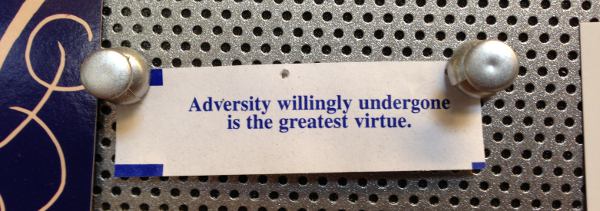
Don’t take this the wrong way, but your body is probably already as screwed up as mine was.
It doesn’t matter if you’re 20, 30, or 60, whether you’re a couch potato or an endurance sport freak, you’re probably just a few movements away from total disaster.
If you don’t believe me, try this: when you have some privacy, take your shirt and shoes off, and roll up your pants so you can see your knees. Walk up to a full length mirror and stop. Or better yet, have a friend take a photo of you facing the camera.
What do you see?
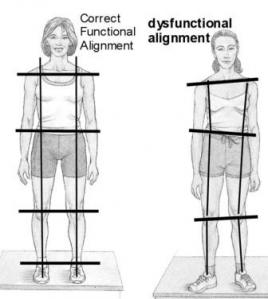 I bet you never noticed that one or both feet turn out and aren’t facing straight ahead, that your belly button isn’t centered over your hips, or that one of your shoulders is higher than the other. What about your feet: do they roll inward (pronate)? Knees: do they roll in or out? Hands: are they flat against the sides of your body?
I bet you never noticed that one or both feet turn out and aren’t facing straight ahead, that your belly button isn’t centered over your hips, or that one of your shoulders is higher than the other. What about your feet: do they roll inward (pronate)? Knees: do they roll in or out? Hands: are they flat against the sides of your body?
If you see nothing but flawless symmetry, congratulations, you’re a cyborg.
For the rest of us, I have some serious news to deliver: any discrepancies here are warning signs that your body is not biochemically sound and that any movements you perform are prematurely wearing things out.
The human body (as we currently use it) is constantly moving out of ‘tune’ – the neutral position from which movement is intended to occur. Most of this is caused not by movement but by lack of it: a lifestyle that makes us sit most of the day.
And here’s the punchline: you can’t hire someone to fix you. You have to do it yourself. And if you want to stay healthy you will have to do it for the rest of your life…
Start looking around and you’ll immediately notice a sea of dysfunctional people. At the office, at the gym, in the park: watch how people stand, sit, and God forbid how they (*shudder*) run.
Part III: Posture that leaves something to be desired.

It was in The 4-Hour Body that I found the first clue that faulty movement patterns based on bad positioning were a big part of my problems.
In the chapter on reversing injuries Tim writes about the Egoscue Method (named after Pete Egoscue and best introduced by his book, The Egoscue Method of Healing through Motion) which he describes as a ‘postural therapy program with the aftertaste of cult.’ Cult because of the following built by the miraculous success of those who’ve tried it.
Despite the shocking expense of visiting an Egoscue Clinic (not covered by insurance, more expensive than PT), by the time I discovered the clinic in downtown San Francisco I was ready to try anything. Ten minutes at the Egoscue clinic taught me more about my issues than the hours I’d previously spent with any other specialist.
My Egoscue therapist Johnny had me stand in the corner and take my shirt off. He then took the extremely unflattering photos featured at the top left of this post.
“You see what’s going on here?” Johnny asked. It was all clear when he drew a line through the middle. My left shoulder was elevated, my hips were cocked to one side, and my feet were everted like a duck.
John asked me if I’d ever played soccer. He said I was probably right-footed, since it’s easy to see which foot I predominantly passed the ball with. I was already surprised that he could figure out all that just by looking at me. Then he had me do this:
“I want you to close your eyes and march in place, knees up.”
I felt like an idiot but marched away for what seemed like several minutes. When I opened my eyes I was now facing the wall—while marching I’d turned 90 degrees to the left without realizing it.
“You see what’s going on here?” Johnny asked again. “Your body is constantly trying to make a left turn because your hips are tilted right and forward. This explains your knee pain since your right foot is turned out, which wears the inside of the right knee, and also why your left shoulder is pushed up and forward, to compensate the turning motion. We can fix all of this.”
I’d found the first piece of the puzzle: my default body position was a mess.
Like driving a car with faulty alignment, I was grinding things down to the hubcaps.
It isn’t difficult to understand how his happened. Essentially I’d been nearly killed by the “real world”. Despite my aggressive fitness schedule I was still spending most of my time not moving, hanging out in dysfunctional positions and not doing anything to fix them.
Work on a computer? Well guess what, unless you pay serious attention to re-tuning your body you’re fu*#&ed. As I learned later, Kelly Starrett goes so far as to say that “sitting is the new smoking.”
Sitting causes us to spend most of the day in compromised body positions, and when we do move it’s within an extremely limited range of motion. How often, for example, do you reach directly overhead? Or sit in a squat position? Or throw something?
The more we move within a box of restricted movement patterns the smaller this box becomes. Once you’ve adapted to these limited positions many normal movements become outliers: try lifting a weight overhead after sitting all day with your shoulders hunched forward. You’ll blow the joint apart. As time goes on, it’s harder to complete normal movements–let alone during exercise–because your body is no longer accustomed to doing them.
It’s basically a positive feedback death spiral.
The more accumulated time you spend in these faulty positions, the more ingrained they become. This means that your body has to be properly re-aligned and constantly restored to neutral. Fail to do this and eventually things will break.
Some of you may be thinking, “yeah but I go to the gym every day.” That’s great, but there’s a big problem here: spending 8 hours melting into an office chair sets you up for failure: every day you’re telling your body that the seated ‘primate-at-the-computer’ posture is the default. This may work well for typing, but it can have disastrous consequences when you do anything else.
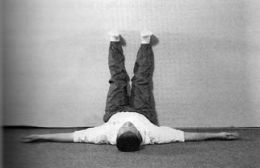 The Egoscue ‘method’, as I learned, is simply a series of multidisciplinary movements (pulled from Yoga, PT, and invented by the founder) designed to restore functional movement patterns and put your body back to neutral. (It seems relatively clear that one of the reasons Yoga is so popular is because it’s a non-specific way to address these issues). Fail to return to neutral before moving and you’re putting your body through a tremendous amount of extra wear and tear.
The Egoscue ‘method’, as I learned, is simply a series of multidisciplinary movements (pulled from Yoga, PT, and invented by the founder) designed to restore functional movement patterns and put your body back to neutral. (It seems relatively clear that one of the reasons Yoga is so popular is because it’s a non-specific way to address these issues). Fail to return to neutral before moving and you’re putting your body through a tremendous amount of extra wear and tear.
Ultimately my experiences at the Egoscue clinic dramatically improved my posture and lead me to the initial conclusion that my knee injury had nothing to do with the squat as a movement pattern. Rather, it had everything to do with wearing the inside of my knee out by years spent walking and running with my right foot turned out. The squat that actually tweaked my knee was really just the final insult on the slow, chronic degeneration caused by these ongoing biomechanical faults. (It was also the result of not knowing what the hell I was doing–more on that later.)
(As another aside: the tilt in my hips also led other Doctors to assume that my legs were a different length, which caused one Chiropractor to prescribe custom orthotics of different heights. Not only was this total BS and expensive, but it ultimately did more harm than good. Read Born to Run and this article if still think shoes have anything to do with healthy feet.)
I performed an Egoscue routine for about a year and watched my feet straighten out, my hips level, and my left shoulder drop to neutral. But something still wasn’t working. I hit a plateau.
As I would learn later, the Egoscue routines were useful, but they didn’t complete the picture. The exercises could get me a lot closer to neutral, to being able to walk and even run again, but they couldn’t get me back to full functional fitness.
It wasn’t until March 2013 that I would figure out why and how to fix things once and for all.
Little did I know while I was fooling around at the Egoscue clinic that another experiment was under way: MobilityWOD.com. I had been introduced to this website back in March 2012 by a friend. At the time it just looked like some cool stretching videos.
It took a full year for me to discover that the key to everything was under development less than 3 miles from my apartment in San Francisco.
Part IV: You both can’t, and aren’t, moving correctly.

March 2013, Moving pretty well on the North Shore of Oahu, Hawaii
“San Francisco? Man if I lived in San Francisco I’d go to Kelly’s gym. That’s where Brian Mackenzie hangs out too.”
Coming from an aspiring Navy Seal and one of the most fit dudes I know, this was a serious recommendation.
I had no idea who Kelly was, but the second name rang a bell. I knew Brian Mackenzie as the ultra-endurance guru that helped Tim Ferris train for his first marathon (as described in The 4-Hour Body). But Kelly’s name kept coming up in relation to some freaky-sounding website called MobilityWOD.
“Is that what you’re watching every night?” I’d been sharing a room with my buddy for the last few weeks and when he wasn’t working out all he did was stare at his laptop and perform what appeared to be some kind of advanced masochistic stretching routine.
“Yup man, every day.”
Time to figure out what MobilityWOD was all about.
I’d been doing a combination Egoscue and fitness routine daily for the last year and a half and was feeling pretty good (I’d also spent the last 3 weeks surfing on the North Shore). The last thing I wanted was to add more to my daily routine.
Turns out this would do more than modify my training program: it would drastically change my plan for the next 4 months and finally fix the nagging injuries that had plagued me for years. Ultimately, it would change my life.
And it all started with just 10 minutes a day.
First of all, ‘WOD’ is a CrossFit term that stands for ‘Workout of the Day’. The site MobilityWOD was started by Kelly Starrett, who as I mentioned is owner of San Francisco CrossFit, a Dr. of Physical Therapy, and recently published author of the magnum opus on fixing your body, Becoming a Supple Leopard.
MobilityWOD was born when Kelly decided to produce a (free) daily video for his self-torture DIY physical therapy routine. The premise is simple: you shouldn’t have to go to a Doctor to fix yourself. Everyone should have a basic understanding of how to do it on their own.
The first thing I did (I highly recommend doing this right now) was navigate to day one, video one on MobilityWod.com, which you can see on the site here (Episode 1: The first of many beat downs) or watch below:
Can you sit in a squat position for 10 minutes? I couldn’t when I first watched this, but after a month of exercises I can do so easily.
Mobility: Restoring normal range of motion by crushing yourself.
The ‘mobility’ part of MobilityWOD is what you may think of as ‘flexibility’ but there’s a lot more going on here than just stretching.
Essentially, even if you know how to move properly you may not be able to because of muscle and joint restrictions. Kelly’s mobility system is a way to systematically attack these restrictions to restore normal range of motion and movement patterns.
A lot of this is pretty masochistic: smashing muscle tissue and pulling it apart to restore normal sliding surfaces and stretch muscle tissue back out. If you know anything about ART (Active Release Therapy) you know how pain can equal a lot of gain when it comes to working through range of motion (note that Tim Ferris listed ART as a major deal in fixing his shoulders).
It turns out that through both use (and disuse) a lot of things in your body get stuck together, short, and tight. You can stretch all day against this, but if you don’t smash up the bits sticking together you’re never going to get anywhere.
The best analogy I’ve heard is of your muscle as a rope. The rope develops knots, and stretching that tissue only strengthens the knots. You have to break the knot apart before lengthening the tissue is going to have any positive effect.
I started watching these videos daily. One video per day, every day. After a week I noticed a huge difference in a lot of basic movements. After 2 weeks I’d become a disciple.
After 3 weeks I decided to stop at Kelly’s gym in SF and fix my problems once and for all.
I had no idea what I was in for.
Entering the pain cave: San Francisco CrossFit
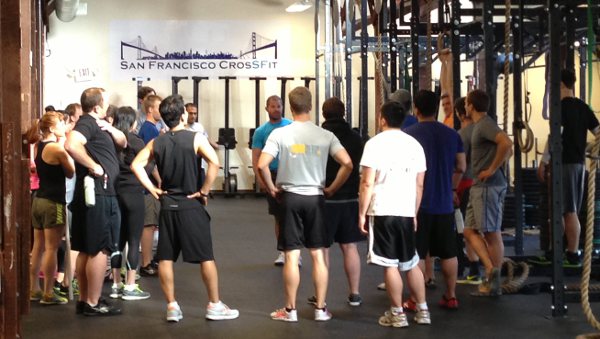
“Your forearms are GROSS dude. GROSS.”
The only response I could make with my grimacing face pressed against the floor was a sort of whimpering sound about climbing a lot. I repeatedly tried to tap out as Kelly’s full 230 lb bodyweight appeared to be resting on my arm. He didn’t even look down, but simply sipped his beer and continued grinding my forearm into the floor.
Just another Thursday night Mobility Class at San Francisco CrossFit.
Despite not wanting to ‘go into the pain cave’, I was there a lot during my time at Kelly’s gym. But I’ve never seen results like this: can you restore normal range of motion in a matter of weeks? Why yes, you can. By grinding through tissues, breaking up knots, restoring sliding surfaces, and then stretching thing out I watched my body’s functionality change almost overnight.
While it was amazing to attend mobility classes with the man himself, Kelly’s doctrine has spread like a wildfire. Not only does MobilityWOD boast 1 million monthly visitors, but Becoming a Supple Leopard has garnered media attention from major outlets like Outside Magazine and ABC.
It’s the book I wish I’d had when I started this journey.
Becoming a Supple Leopard is (in my opinion) one of the most important works on human health and fitness ever produced. It’s the synthesis of a tremendous amount of understanding of the human body, and for the first time, packaged in a way that the average person on the street can both understand and effectively use it (btw, you can download 44 pages of the book free to check it out)
But the book isn’t just about mobility, and neither was my experience at San Francisco CrossFit. I also had to re-learn how to move.
Motor Control: You just don’t know how to move properly.

I had stepped into SF CrossFit on April 23, 2013 a bit nervously – I had no idea if I could hack it. Despite being fit (I had just surfed 2-4 hours a day for 6 straight weeks on the North Shore) my right knee still bothered me and my left shoulder prevented any overhead movements with weight (since that’s how I originally injured it). I thought I might flunk out or have to take repeated intro courses, never making it into the actual classes.
See, you can’t even get into regular CrossFit classes without a multi-day introductory course that teaches students proper weightlifting technique and introduces the specific movements (like Olympic lifts).
In the first 20 minutes of this training my head almost exploded: nearly every injury I’d experienced, every physical limitation could have been ameliorated or prevented by learning the principles of movement I was introduced to there.
It turns out that not only did I have limited range of motion and faulty biomechanics that I’d been fixing with MobilityWOD, I also simply didn’t know how to move properly.
That’s correct: before this training I both didn’t understand how to perform basic exercises like the squat or the pushup properly, and even after learning how I initially didn’t have the motor control to perform them well.
Most of this has to do with never receiving real instruction. Sport-specific coaching aside, my information about strength training always came from word of mouth, online videos, and reading bodybuilding magazines. I don’t think I need to explain why this was a mistake.
Bio-mechanically speaking, there is a right way to move the body, and the general principles involved link the most basic movements to the most complex. Suffice to say, if you haven’t received some kind of training on proper movement and technique you’re likely doing it wrong.
I won’t go into detail here because although simple concepts they take work to master, and a few sentences in this post won’t do them justice. It’s all very clearly explained in Kelly’s book, which I now recommend as the Bible of human movement and rehabilitation.
To underscore the point here: the inability to perform a movement properly means either a) you don’t’ know how to do it correctly (knowledge or motor control) or b) you can’t perform it correctly because of tissue restrictions that inhibit movement. Kelly’s mobility system, as outlined on MobilityWOD.com and in Becoming a Supple Leopard, will teach you how to fix both these problems. Note that when I say ‘fix’ I mean ‘get started fixing’. This is another one of those things where you get out what you put in.
A few weeks of training at San Francisco CrossFit became 2 months. I realized that a lot of what I had accomplished with the Egoscue routines could have been dealt with by understanding, opening up, and strengthening proper movement patterns.
The experience there turned out to be the most important thing I’ve ever done for my health. I started to feel like I was 25 again (I’m 31). For the first time in years I could push it as hard as I wanted because I had both learned which faulty mechanics were at the root of my problems and how to fix them.
I also learned that Kelly’s system of mobility and CrossFit as a discipline create the perfect synergy for restoring and advancing the human athletic potential we’re all born with.
Part V: The CrossFit connection: weight and speed as diagnostic tools
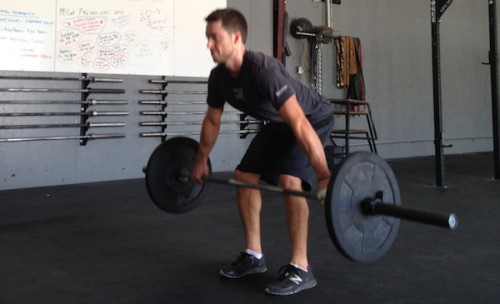
If you haven’t ‘done’ CrossFit you probably think it’s a fad for meatheads or people that want to do harder aerobics. I sure did.
During my mid-twenties I thought I was fit enough and didn’t need to add elementary-school rope climbs or ‘risky’ Olympic lifting movements into my training. I completely ignored CrossFit for the better part of a decade.
It turns out, as with most things, I didn’t know what I was talking about. After two months at San Francisco CrossFit I can say that the program there is the best physical training I’ve ever done. And yes, it works. The most surprising part isn’t the strength gains, but the broad fitness level I’ve developed. After 4-5 days a week of CrossFit classes everything else is easy. Without any additional training I’ve been rock climbing at a level that would usually take a month of prep, blasted through 1-hour (fast) runs without even feeling it, and survived hiking 76 miles on the PCT with a couple thru-hikers who clock 20 miles per day. The effects of short, intense metabolic and strength conditioning are dramatic.
But I’m hesitant to recommend CrossFit in a broad stroke since the quality of coaching varies so much by gym. After spending time in a few other affiliates over the last few months I’ve seen some tremendously bad form and poor instruction on the fundamentals.
Additionally, without the ‘mobility’ component, CrossFit isn’t a complete picture. The way Kelly sees things, the movements in CrossFit are diagnostic tools, and the gym is the lab where you play around with these tools to expose functional deficiencies and then fix them. Not being able to properly execute a movement isn’t just about ‘lifting weights’ or being able to arbitrarily perform exercises for the sake of fitness–it has broad applications to every motion you go through life.
As Greg Glassman, the founder of CrossFit, argues, being able to squat correctly is ‘vital to a fulfilling existence as a functionally moving human being.’ (12)
Once you address the more fundamental issues—which for example, sitting in the squat I was able to do in less than a month—you start to challenge more complicated movements with weight and speed to highlight and then fix other deficiencies.
Again, the most surprising thing is the broad application here: if you can’t perform an overhead squat (picture at the top of the post), well guess what: the shoulder range of motion that limits you here will also prevent you from swimming properly (surfing, anyone?). Can’t jump-rope? Well, since the jump-and-land here approximates proper foot-strike in running you damn well shouldn’t do that until you work it out. All of the movements I’ve been exposed to in CrossFit are made to challenge functional movement patterns that basically apply everywhere. If you can’t do it perfectly, you have work to do.
CrossFit is definitely about strength and fitness, but with an emphasis on creating a functional platform for anything you want to do in life. It’s about burning through flawless movement patterns by fixing mobility issues, then strengthening those with speed and weight to a point that they can stand up to anything life can throw at you.
In short, it’s about restoring and expressing the athletic potential you were born with. But it’s entirely up to you to make it happen. As Kelly’s tagline states: “All human beings should be able to perform basic maintenance on themselves. It is both a human right and a responsibility to understand how your body works.”
Conclusion: Human Performance — This is only the beginning.
The proof is in the pudding, as they say. I haven’t felt this good in years.
But am I 100% yet? Not even. I’m not sure I’ve ever reached my full potential, but at least I now have the tools and the roadmap to continuously work in the right direction. The combination of limiting time spent in dysfunctional positions (I work at a stand-up desk now), restoring normal mobility (30-60 min every day), then strengthening proper movement patterns with the right training (CrossFit), is almost unstoppable.
After all this—three years of searching and now restoring my body to a pretty solid fitness level—I’m really just getting started. Kelly frequently talks about the human performance revolution currently underway. Today, more than any other time in history, we have the tools and information to maximize our genetic potential, let alone just live a pain free life doing the things that humans are supposed to be able to do.
The only catch? It’s up to you to do the work. The rehabilitation and maintenance of your body is never finished, and besides being pain free we’re all leaving a ton of potential still on the table.
As Kelly quips: “Is it important? Then you should probably work on it every day.”
If you’re just getting started, check out these resources. Thanks a lot for reading this, and please let me know if you have any feedback, questions, or other insights on the subject. Here’s to your health.
Cliff Notes on How I broke my body and fixed it:
- The most important thing you can fix immediately is learning how to move properly. Learn how the body is supposed to work together and develop proper motor control for movements by reading Becoming a Supple Leopard and/or attending a CrossFit training class (I don’t know of other resources that reliably provide similar training). Believe me, learning how to move properly is no joke: it takes dedicated work.
- Once you’ve learned how to move properly you will quickly find out where mobility restrictions limit proper movement. Systematically start fixing these by working through MobilityWOD.com exercises (most of these videos are free) as well as addressing them point by point in Becoming a Supple Leopard.
- For the uninjured, I recommend finding a good CrossFit affiliate and training there. The reason has a lot to do with supervision: fitness training is hard to do correctly without a coach. You can find a local CrossFit gym almost anywhere.
- Check out the additional resources below for more.
Resources
- MobilityWod.com – Now has pro subscription options and several years of content. Fastest way to get started is to check out the free videos (there are 500 of them) starting on page 1.
- Becoming a Supple Leopard: The Ultimate Guide to Resolving Pain, Preventing Injury, and Optimizing Athletic Performance by Dr. Kelly Starrett. Check out the free 44-page sample for an intro.
- Bulletproof your mobility. Interview with Kelly on the BulletProof Exec podcast.
- The 4-Hour Body: An Uncommon Guide to Rapid Fat-Loss, Incredible Sex, and Becoming a Superhuman by Timothy Ferris
- The Egoscue Method of Healing Through Motion by Pete Egoscue
- Egoscue website and San Francisco Egoscue Clinic
- San Francisco CrossFit – Kelly’s human performance lab.
- CrossFit.com – The main website for CrossFit, with daily workouts and instructional videos for every exercise you can imagine. Also check out the fitness articles from the CrossFit journal.
- CrossFitEndurance.com – Brian Mackenzie’s contribution to the CrossFit ecosystem. Guess what: running is also a skill, and you most likely do it wrong. Fix your technique before it fixes you.
- Power.Speed.Endurance – Brian Mackenzie’s book on CrossFit endurance training. If you run you need to check this out.
- TheTravelingWOD.com – Great resource for travelers that want to stay in shape.
- Inside the Box: How CrossFit® Shredded the Rules, Stripped Down the Gym, and Rebuilt My Body – More about the story behind the CrossFit revolution.
- Genetic Potential TV – Youtube show hosted by Kelly Starrett and Brian Mackenzie. Extremely interesting stuff.
- creativeLIVE “Maintaining your body w/ Kelly Starret” – Online class on movement and mobility. Free on Youtube, or buy the whole course.
Acknowledgements
I’d like to thank the following people for bringing me back from the old folks home: Tim Ferris, Johnny, Justin, John of SFCF, and of course, Kelly Starrett. You guys kick ass.




